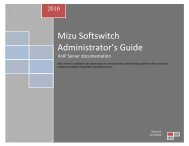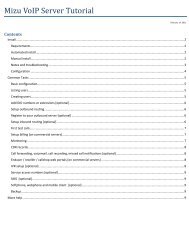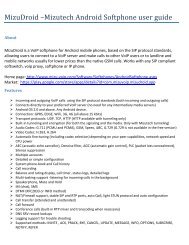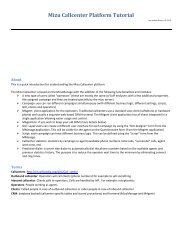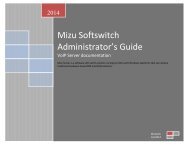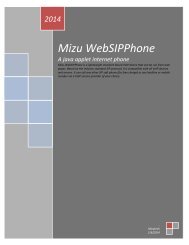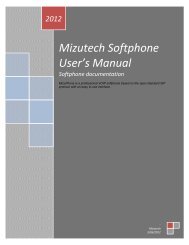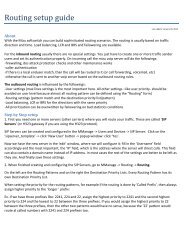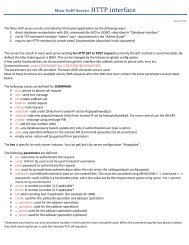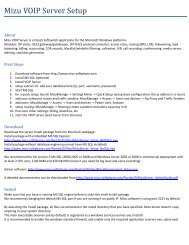Mizutech VoIP Tunneling and Encryption - Mizu Voip
Mizutech VoIP Tunneling and Encryption - Mizu Voip
Mizutech VoIP Tunneling and Encryption - Mizu Voip
Create successful ePaper yourself
Turn your PDF publications into a flip-book with our unique Google optimized e-Paper software.
<strong><strong>Mizu</strong>tech</strong> <strong>VoIP</strong> <strong>Tunneling</strong> <strong>and</strong> <strong>Encryption</strong><br />
Technical details<br />
November 26, 2010<br />
About<br />
The <strong>Mizu</strong> <strong>VoIP</strong> tunneling solution is a set of client <strong>and</strong> server side software capable to bypass voip blockades, firewalls,<br />
NAT’s, STUN <strong>and</strong> HTTP proxies.<br />
For a detailed presentation please visit this link: http://www.mizu-voip.com/Products/<strong>VoIP</strong>Tunnel.aspx<br />
All configuration <strong>and</strong> management can be done by <strong><strong>Mizu</strong>tech</strong> support. However you can use the tunneling guide <strong>and</strong> the softswitch<br />
admin guide to manage the <strong>VoIP</strong> tunneling server yourself.<br />
Once the server is installed, you will usually need to perform only a few management tasks which are the followings:<br />
- edit your registrar, inbound <strong>and</strong> outbound server(s) settings (all these settings can point to a single server)<br />
- monitoring (running calls, CDR records, statistics)<br />
- backup <strong>and</strong> cloning<br />
Install, configuration <strong>and</strong> support services are included with each license plan. Contact support@mizu-voip.com<br />
Included software<br />
Server:<br />
On the server side a special <strong>VoIP</strong> software is used whose task is to encrypt all communication from/to the clients <strong>and</strong> to<br />
forward the calls to your server(s) using the common SIP protocol.<br />
- <strong>Mizu</strong> softswitch with built-in tunneling (This is a full featured softswitch including user management <strong>and</strong> billing features)<br />
or<br />
- <strong>Mizu</strong> <strong>Tunneling</strong> Server (This can be used with any existing softswitch or voip servers. This software is based on the <strong>Mizu</strong><br />
softswitch but unlike a softswitch it doesn’t require provisioning <strong>and</strong> billing configuration)<br />
Client:<br />
The followings are available on the client side:<br />
- softphone (windows desktop)<br />
- webphone (platform independent java applet. Runs from any J2SE capable browser)<br />
- mvoiptunnel (client software that can be integrated with any third party softphone on the Windows platforms)<br />
- mvoiptunnelsrv (client service to enable tunneling services for any third party SIP clients: ATA’s, IP phones, softphones, etc)<br />
Technical details<br />
The tunneling server is capable to use various tunneling <strong>and</strong> encryption transport methods to bypass all <strong>VoIP</strong> filtering <strong>and</strong><br />
firewalls running over a full featured class 4/5 SIP stack with all common functions included (registrar <strong>and</strong> proxy/SBC functionality,<br />
voice calls, video calls, presence, IM, all DTMF methods, PBX functions like call hold, transfer, conference, etc <strong>and</strong> with support for<br />
all common codec’s: g729, g723, g711, GSM, speex wideb<strong>and</strong> <strong>and</strong> ultra-wideb<strong>and</strong>, iLBC, g726, g722, L16)<br />
There is a few different built-in encryption methods based on symmetric keys to speed-up the connect times. Additionally it can<br />
use compression to further reduce b<strong>and</strong>width utilization.<br />
The server software is optimized to the Microsoft Windows operating systems with an MS-SQL backend (although database<br />
operations are not so critical compared with a traditional softswitch. The database is used only to store the configuration,
temporary user records <strong>and</strong> CDR records for local statistics). The server application is running as a st<strong>and</strong>ard NT service <strong>and</strong> is<br />
capable for both client side <strong>and</strong> server side load balancing <strong>and</strong> failowering.<br />
The tunneling server can be used in the following ways:<br />
- one tunneling server - one softswitch (this is usual. The tunneling server can be installed in the same box where your<br />
softswitch is running or on a separate box)<br />
- one tunneling server - many softswitch (if you have many softswitch, each with low traffic)<br />
- many tunneling server - one softswitch (if your softswitch can run more than 10000 simultaneous calls, than the<br />
performance of one tunneling server is not enough <strong>and</strong> you need to use more tunneling servers)<br />
Performance while using encrypted transport with tunneling <strong>and</strong> encryption on a Xeon E5620 with 6 GB RAM (64 bit Windows<br />
Server 2008):<br />
- simultaneous calls: 3500<br />
- registered users: 45000<br />
- BHCA: 432000 (120 calls/sec)<br />
- signaling message processing/sec: 1600<br />
The client will try to use the “best” available transport protocol. There are 10 different built-in transport protocols that can be<br />
used. The following table will present the most important categories.<br />
Direct UDP<br />
(no tunneling or<br />
encryption)<br />
Encrypted UDP<br />
Direct TCP or via<br />
http proxy connect<br />
HTTP 1.1. or<br />
chunked transfer<br />
HTTP 1.0 with or<br />
without proxy<br />
Quality in good 10 10 11 9 7<br />
network conditions<br />
Quality in bad 8 8 6 5 3<br />
network conditions<br />
(8% packet loss,<br />
150 msec jitter)<br />
Server Processing 1x 1,5x 2,5x 3,5X 6x<br />
Load<br />
Delay 50 msec 50 msec 75 msec 250 msec 400 msec<br />
Protocol Overhead<br />
<strong>and</strong> Ethernet<br />
b<strong>and</strong>width usage<br />
with G.729<br />
0% (32 Kbits) 1% (32 Kbits) 20% (38 Kbits) 30% (41 Kbits) 55% (50 Kbits)<br />
Circumstances<br />
Clear SIP/RTP<br />
protocol<br />
When SIP/RTP is<br />
blocked (voip<br />
filtering)<br />
When all UDP is<br />
blocked or from<br />
behind SOCKS<br />
proxies<br />
From behind HTTP<br />
proxies <strong>and</strong><br />
corporate firewalls<br />
In very rare<br />
circumstances if<br />
everything other is<br />
blocked behind an<br />
outdated corporate<br />
firewall<br />
The following steps are performed by the clients:<br />
1. On startup the clients will load its configuration (this can be hardcoded, stored in a local configuration file or downloaded a<br />
from predefined location)<br />
2. The client first will try to connect directly to your server(s) (to the “most available server” or based on autoprovisoning in<br />
case if you will have multiple servers). This is an optional step.
3. Select r<strong>and</strong>om UDP port (without any client-server negotiation from a r<strong>and</strong>om set of ports. Using different ports every<br />
week)<br />
4. Try encrypted UDP communication (to the “most available tunneling server” or based on preconfigurations in case if you<br />
have multiple tunneling servers)<br />
5. Will do a quick test to detect if UDP quality is lowered. If yes, then will not use UDP transport (will simulate RTP traffic for 1<br />
second. If the measured packet loss is higher than 14%, then it will not use UDP)<br />
6. If this fails then will try direct TCP connection (usually to port 443)<br />
7. If this fails the will try tunneled TCP connection via socks or proxy<br />
8. If this fails the will try proxy traversal with connect, if there is a local http proxy<br />
9. If this fails the will try http 1.1 with or without proxy (usually to port 80)<br />
10. If this fails the will try http 1.0 streaming with chunked length encoding with or without proxy<br />
11. If this fails the will try http 1.0 with or without proxy<br />
All this is done during startup (at login, first connect or call) <strong>and</strong> will take 1-3 seconds.<br />
While using UDP transport the packets are sent with variable packet length to harden the detection by voip blockades.<br />
The following negotiations can be done after startup:<br />
1. During the subsequent registrations, if the protocol is UDP <strong>and</strong> the communication is blocked, then will switch to TCP<br />
automatically<br />
2. During a call if UDP quality is lowered (packet loss higher than 20%) then will switch to TCP automatically (without call<br />
interruption)<br />
3. While using TCP, it can switch to HTTP automatically if TCP is blocked or network conditions have changed.<br />
The clients will remember its previous activity <strong>and</strong> in subsequent startups might act in a different way. For example if there was<br />
more than 3 subsequent UDP to TCP switch during a call (due to high packet loss), then in the next startup it will not try UDP at all.<br />
Both client <strong>and</strong> server side load balancing <strong>and</strong> failowering is supported.<br />
When using client side load balancing, the client will use the “most available” server which means a combination of the followings:<br />
- the server used before by the same client<br />
- the most closest server (where the network round-trip time is the smallest)<br />
- the number of users <strong>and</strong> simultaneous calls on the servers<br />
- the CPU load <strong>and</strong> RAM usage of the servers<br />
Server requirements<br />
OS: Windows Server 2003 or 2008 (Windows XP, Vista or 7 for testing)<br />
Database: MS SQL Express 2005 or 2008 for less than 1500 simultaneous calls (included in the install package), full MSSQL<br />
(2000, 2005 or 2008) for more calls.<br />
CPU: depending on the usage (the server can take advantage from up to 32 cpu core)<br />
RAM: depending on the usage (minimum 1 GB for 200 simultaneous calls)<br />
Disk: 40 GB with logs turned off <strong>and</strong> or 192 GB for maximum trace level<br />
Network: ~10 Mbit/s for 300 simultaneous calls (depending on the transport protocol <strong>and</strong> the codec used)<br />
Typical recommended configuration for <strong>VoIP</strong> service providers between 500 <strong>and</strong> 5000 simultaneous calls: 2 servers with 4 or 8 CPU core, 4 GB RAM, <strong>and</strong> 256 GB<br />
disk space. By using 2 servers you can separate the application server from the database server <strong>and</strong> also you will have a hot backup.<br />
Copyright © 2010 <strong><strong>Mizu</strong>tech</strong> SRL




